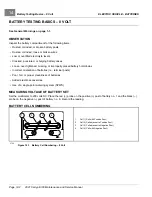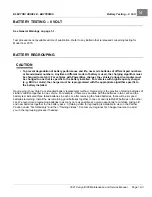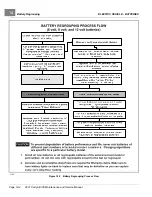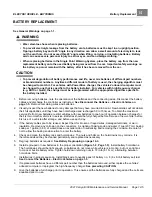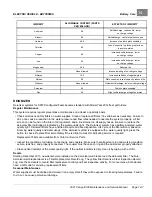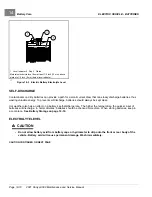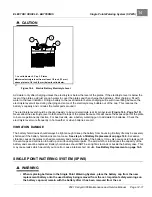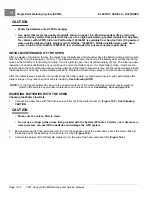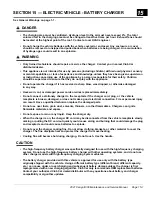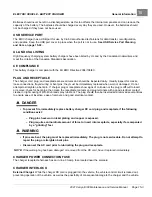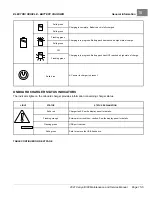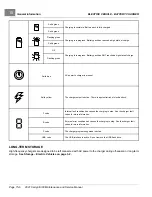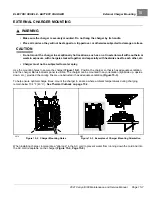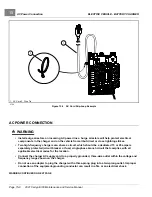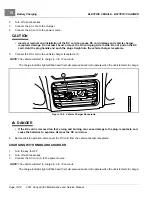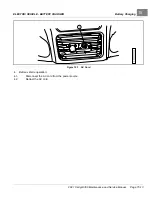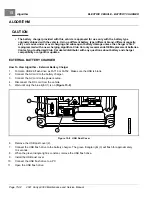
14
Battery Storage
ELECTRIC VEHICLE - BATTERIES
CAUTION
• If at any time water overflows from the batteries, immediately stop the refill process, disconnect the
pressure regulator from the battery fill coupling, and call for service.
3.
When the red flow indicator balls stop moving, immediately press the grey button to disconnect the hose-end
assembly from the battery fill coupling (9), and squeeze the dust cover (10) to lightly secure it to the male
connector of the battery fill coupling
4.
Place the battery fill coupling into the space between the batteries and the car body. Leaving the fill coupling on
top of the battery bank or tucked between the batteries can result in coupling damage.
5.
Turn the water faucet off when finished filling the vehicle(s).
BATTERY STORAGE
See Storage – Electric Vehicles, Section 3, Page 3-2.
FLEET ROTATION
Rotate vehicle usage. It is very hard on batteries if the last vehicles in at night are the first ones out in the morning.
Spread the workload evenly, giving all vehicles the same amount of use. This will keep your fleet in balance and will
not overwork certain sets of batteries.
See following NOTE.
NOTE:
When vehicles are being rotated, the CDT (Controller Diagnostic Tool) can be a very helpful service tool.
Monitoring the value of the Odometer or Amp-Hours with the CDT simplifies vehicle usage scheduling.
Monitor Menu, Section 11, Page 11-9.
DEEP-DISCHARGE
Never discharge batteries to the point the vehicle will no longer operate. This will considerably shorten the cycle life of
the batteries, and may permanently damage the batteries. It is possible the batteries will not accept a charge if they are
completely discharged. The deeper the discharge, the harder it is on the batteries. For this reason, it is recommended
that electric vehicle batteries be charged after each use (provided the charge cycle will not be interrupted and the
charger will be allowed to shut off automatically). Placing the batteries on charge after each use reduces the depth of
discharge and prolongs battery life.
EARLY EXCESSIVE DISCHARGING
When vehicle batteries are new, they do not reach their full capacity until they have been discharged and recharged
50 to 70 times. If they are excessively discharged early in their life, their effective service life will be shortened. It
is advisable to limit the use of any vehicle with new batteries for at least the first four weeks and then gradually
increase their range.
Page 14-14
2021 Carryall 300 Maintenance and Service Manual
Summary of Contents for Carryall 300 2021
Page 2: ......
Page 16: ......
Page 551: ...80 2018 by Kohler Co All rights reserved KohlerEngines com 17 690 15 Rev...
Page 565: ...GASOLINE ENGINE HARNESS Wiring Diagrams Gasoline Engine Harness 26...
Page 566: ...Page intentionally left blank...
Page 567: ...GASOLINE KEY START MAIN HARNESS Wiring Diagrams Gasoline Key Start Main Harness 26...
Page 568: ...Page intentionally left blank...
Page 569: ...GASOLINE PEDAL START MAIN HARNESS Wiring Diagrams Gasoline Pedal Start Main Harness 26...
Page 570: ...Page intentionally left blank...
Page 571: ...GASOLINE INSTRUMENT PANEL HARNESS Wiring Diagrams Gasoline Instrument Panel Harness 26...
Page 572: ...Page intentionally left blank...
Page 573: ...GASOLINE FNR HARNESS Wiring Diagrams Gasoline FNR Harness 26...
Page 574: ...Page intentionally left blank...
Page 575: ...ELECTRIC MAIN HARNESS Wiring Diagrams Electric Main Harness 26...
Page 576: ...Page intentionally left blank...
Page 577: ...ELECTRIC INSTRUMENT PANEL HARNESS Wiring Diagrams Electric Instrument Panel Harness 26...
Page 578: ...Page intentionally left blank...
Page 579: ...ELECTRIC ACCESSORIES HARNESS Wiring Diagrams Electric Accessories Harness 26...
Page 580: ...Page intentionally left blank...
Page 588: ...NOTES...
Page 589: ...NOTES...
Page 590: ...NOTES...
Page 591: ...NOTES...
Page 592: ...NOTES...
Page 593: ...NOTES...
Page 594: ...NOTES...
Page 595: ......
Page 596: ......



